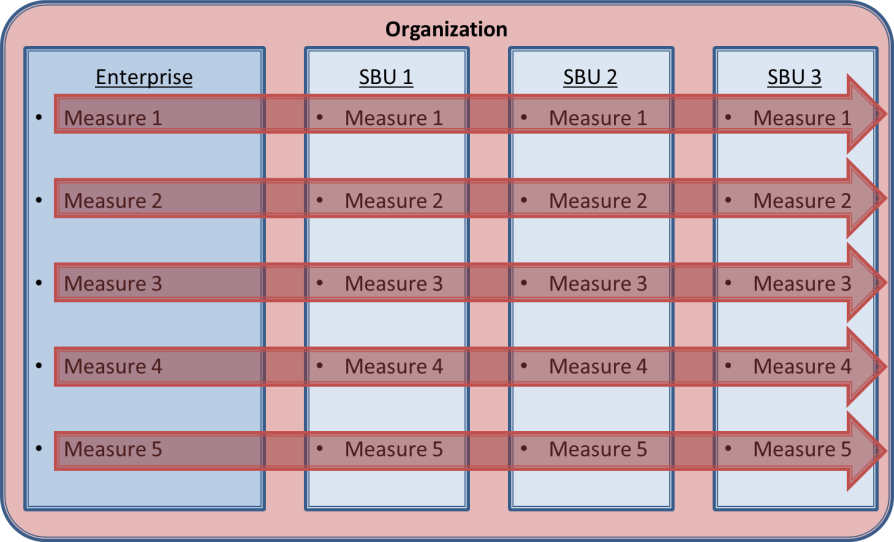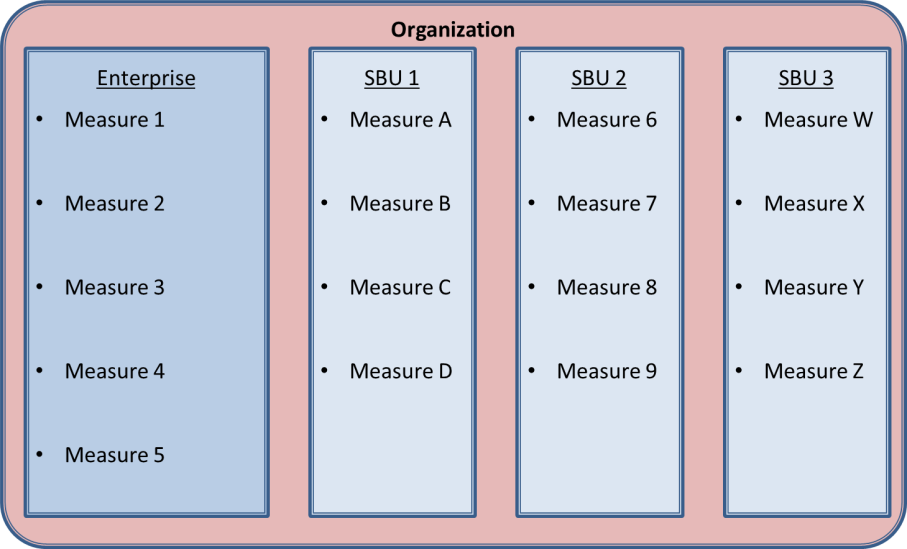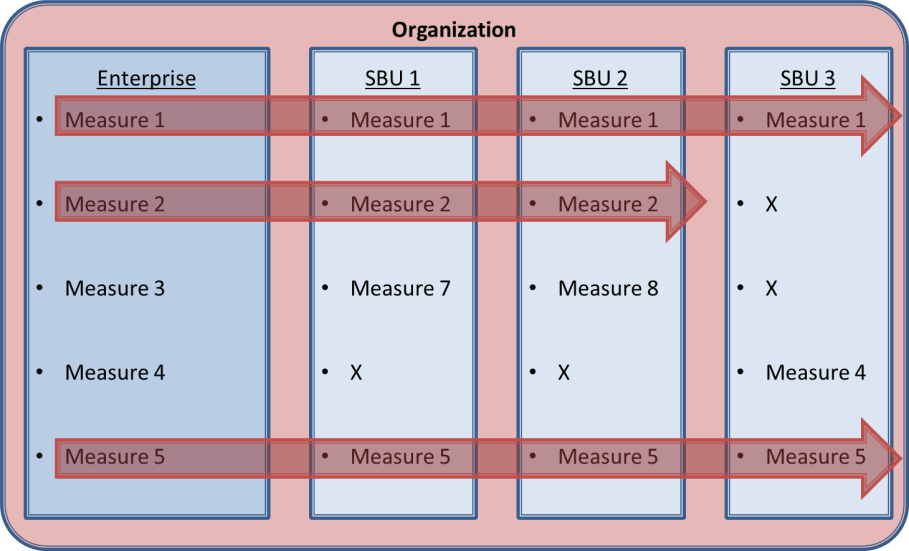
Models of Organization Alignment: Executing Strategy
The difference between the success and failure of an organization's strategy often comes down to how well the organization executes the strategy at all levels. One of the key areas for strategy execution is the organization's strategic business units (SBUs) – smaller, distinct entities within the larger organization that serve specific external markets and may even have their own, distinct business strategy that merely complements the larger organization's.
For a health care system, the SBUs might be the individual hospitals or clinics within the system. For a school district, the SBUs would be either school zones within the district (if it is a large district) or the schools themselves and different departments such as the Curriculum department and the Operations department.
Once the corporate, or enterprise-level, strategic plan, objectives, and measures are set, how can leadership oversee the execution of the strategy across the SBUs?
There are three primary options for executing a strategy and cascading performance measures across organizations: the Shared, Contributory, and Hybrid frameworks. Which framework is best for your organization depends on how your organization is structured and how you intend to execute your strategy.
Shared Framework: With this approach, leadership requires SBUs to use the same enterprise measures as the overall organization. This framework is best when SBUs do not have significant autonomy and are closely connected to the mission and objectives of the larger organization.
In the Shared Framework, the organization adopts a list of enterprise measures to track execution of its strategy. For example, a school district might measure "graduation rate" or "increase in number of schools in good standing;" a health care system might measure "cost per case" or the "average number of days per hospital stay;" and a charity might use an enterprise measure of "percent increase in donations." These enterprise measures show how well the organization is doing in achieving its objectives.

However, when the organization consists of several SBUs that operate with little, if any, autonomy, and leadership needs to track the SBUs' performance, they can use the Shared Framework approach and mandate that the SBUs use the same enterprise measures to track and report on their performance.
The Shared Framework is ideal for organizations with SBUs that are closely connected to the overall mission and whose work is directly applicable to the organization's objectives – the SBUs should have most of their activities and goals in common with the organization itself. For a Shared Framework to succeed, both the SBUs and enterprise leadership should be "speaking the same language" when describing their performance measures.
Contributory Framework: With this model of executing strategy and measuring performance, the organization's leadership allows the SBUs to choose the measures they want to use. With a Contributory Framework, the organization also adopts a list of enterprise measures and there are several SBUs whose performance must also be measured, but the SBUs have a greater level of autonomy than with the Shared Framework.

The Contributory Framework is best for situations where each SBU executes only a portion of the overall organizational strategy--not necessarily common activities--requiring them to report unique measures to leadership. For example, a school district might have multiple SBUs or departments that execute different parts of the school district's overall strategy. The Curriculum department, the Operations department, and the individual schools would all conduct different activities that are important to the overall school district strategy, but they would be measured differently from the activities supporting the top-level enterprise objectives.
Hybrid Framework: In the Hybrid Framework, leadership mandates the use of some enterprise measures but allows SBUs to adopt some of their own as well. This is a blend or "hybrid" of the Shared Framework and Contributory Framework approaches; with the Hybrid Framework, the organization also adopts enterprise measures, but the SBUs are only required to adopt some of these enterprise measures, and they are then free to adopt whatever other measures they choose – whether from the list of enterprise measures or of their own devising. This arrangement gives SBUs the flexibility to adopt their own unique measures while still being accountable for some key enterprise measures that they have in common with the rest of the organization.

For example, a hospital in a health care system may adopt the mandated enterprise measure of "average number of days per hospital stay," the non-mandated enterprise measure "percent employee satisfaction", and its own unique measure "time to discharge."
The Hybrid Framework is ideal for organizations whose SBUs have a certain level of autonomy and want to adopt measures that support the larger work of the organization while still allowing the SBUs to focus on their immediate objectives.
Which framework your organization adopts depends on the structure and culture of your organization and which framework best fits your requirements. Organizations that are "top-down" in their governance model will do best with the Shared Framework, keeping everyone on the same page in their strategic performance measures. Organizations that have a culture of greater autonomy can choose a Contributory Model to enable their SBUs to chart their own path and measure the results that matter most to them. Other organizations that have a mix of "top-down" hierarchy and "bottom-up" autonomy can use the Hybrid Framework for a combination of consistency and flexibility.



June 2021
| S | M | T | W | T | F | S |
|---|---|---|---|---|---|---|
| 1 | 2 | 3 | 4 | 5 | ||
| 6 | 7 | 8 | 9 | 10 | 11 | 12 |
| 13 | 14 | 15 | 16 | 17 | 18 | 19 |
| 20 | 21 | 22 | 23 | 24 | 25 | 26 |
| 27 | 28 | 29 | 30 |
Monthly Archive
June 2014 (1)
May 2014 (2)
March 2014 (1)
February 2014 (2)
January 2014 (1)
December 2013 (1)
October 2013 (2)
September 2013 (1)
July 2013 (2)
June 2013 (2)
April 2013 (1)
March 2013 (3)
February 2013 (4)
January 2013 (7)
December 2012 (4)
November 2012 (8)
October 2012 (9)
September 2012 (5)
August 2012 (6)
July 2012 (5)
June 2012 (7)
May 2012 (8)
April 2012 (5)
March 2012 (5)
February 2012 (6)
January 2012 (6)
December 2011 (7)
November 2011 (9)
October 2011 (9)
September 2011 (2)
August 2011 (8)
July 2011 (6)
June 2011 (8)
May 2011 (12)
April 2011 (5)
March 2011 (1)
February 2011 (2)
January 2011 (4)
December 2010 (6)
November 2010 (3)
October 2010 (5)
September 2010 (4)
August 2010 (3)
July 2010 (2)
June 2010 (1)
May 2010 (2)
April 2010 (1)
March 2010 (3)
January 2010 (4)
December 2009 (1)
November 2009 (1)
October 2009 (1)
September 2009 (3)
August 2009 (2)
July 2009 (3)
June 2009 (3)
May 2009 (6)
April 2009 (5)
March 2009 (3)
February 2009 (2)
January 2009 (2)
December 2008 (2)
November 2008 (2)
October 2008 (4)
September 2008 (6)
August 2008 (5)
July 2008 (4)
June 2008 (9)
May 2008 (5)
April 2008 (6)
March 2008 (8)

